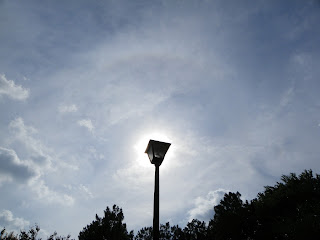As you can see, there are very noticeable odd radius
halos
Same, but unsharp masked. The 9° and 18° halos are noticeable.
Odd radius halo displays usually have broad 22° halos, this is because of the combined 20,22,23, and 24 degree halos. The odd radius halos are usually very faint as well. A convex mirror is almost a must. To show how faint they can be, here are pictures from a display on June 1st 2011. Notice the 18° halo to the right of the street lamp.
I would not have seen this without a convex mirror!
Same but USM, possible 9° halo and 18° halo.
The first odd radius halo I saw was a 23 degree plate arc I observed in September 2010. It was quite faint and I was new to halos, so I didn't know if it was a Parry arc or a 23 degree plate arc. However, at the sun elevation at the time, the Parry arc would be touching the 22 degree halo, but this arc wasn't. It was about a degree away, making it 23 degrees from the sun.
Odd radius halos actually might not be rare. What is rare is for them to be strong enough to actually see. Pyramidal crystals are not rare, but they just do not occur in enough quantity very often. Sometimes there could be odd radius halos, that you can only see after stacking and unsharp masking images.






